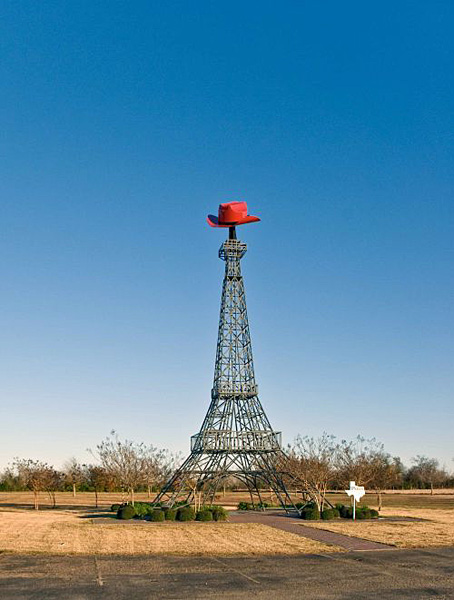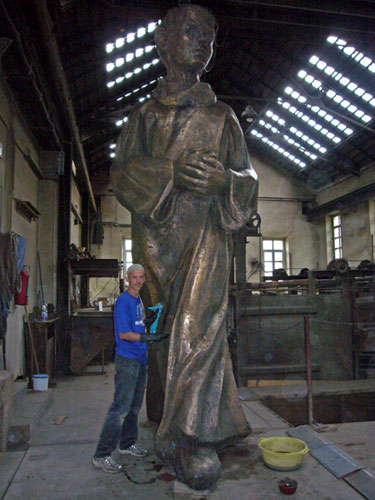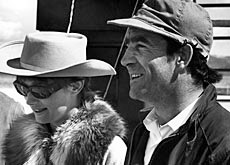From Paris, Texas to Aarau, Aargau

A red cowboy hat perches on top of a model Eiffel tower – welcome to Paris, Texas, the subject of Swiss-American artist duo Hubbard and Birchler's latest work.
The video installation Grand Paris Texas is having its Swiss premiere at the Aargauer Kunsthaus fine arts museum, which is hosting the largest overview of the couple’s art to date. It is also a proud moment for the museum as it celebrates a local boy’s success.
No Room to Answer, featuring work by the American Teresa Hubbard and the Swiss Alexander Birchler, opened at the Aarau-based museum on September 5. The show is something of a coup for the northern Swiss town, population around 16,000.
“I believe everyone in Aarau [the capital of canton Aargau] is really proud since Alexander is from the region – he grew up in nearby Baden. And now he has this international career and comes back to show an overview of his work,” said Aargau Kunsthaus director Madeleine Schuppli, who is also the exhibition’s curator.
Hubbard and Birchler, who are now based in Texas, met at an artists’ residency in Banff in Canada and have been working together for almost 20 years.
Their video and photographic works, which have been shown at the Venice Biennale and the Whitney Museum in New York among other places, are characterised by meditations on time and space.
Creative process
Hubbard told swissinfo.ch that their different backgrounds helped their creative process.
“I come from a background in literature and writing and Alexander comes from a background in drawing and I’d say his education in the arts in Switzerland is much more about the craft of making, whereas my education in the US was more conceptual and about ideas,” she said.
These different approaches allowed them to reach “a third place”. “It’s not a little bit of me, a little bit of him – it’s rather this third place that neither of us would have reached alone,” Hubbard explained.
The result is often complex and challenging. Grand Paris Texas is no different, even if at almost an hour it is the longest video the couple has ever made. Hubbard said the film interwove three premises.
“The first is the subtext of [German director] Wim Wenders’ famous film Paris, Texas, which was a very important film for Alexander and me when we were growing up as teenagers,” she said.
“Although Wenders used the name of the town, it on a superficial level has nothing to do with the town – the film was not shot there, none of the film production involved any of the people there, yet the town has achieved a certain notoriety and we explore that in the film.”
Decayed grandeur
They then go on to have a look at The Grand, a dilapidated movie theatre in downtown Paris, which closed its doors ten years ago.
The third strand involves interviews with the locals. The Grand’s once bustling heydays are poignantly outlined by an elegant old lady who once sold sweets there as a teenager.
Out-of-town multiplexes have led to the death of The Grand, a situation which even some of the younger generation laments. As one young woman says, you can’t watch a good movie at a multiplex.
Push the boundaries
Hubbard said that, as in many of the couple’s other works, they were aiming to “push those boundaries” about perceptions of documentary and fiction as well as consider the relations between the two genres.
“One of the main differences to our other works is that there is a fixed starting point. In many, although not all of our other video works, the whole narrative is structured as a loop or a kind of shape and there’s much less dialogue,” she said, referring to works such as the six-minute Single Wide, which shows a single event – a crash into a trailer home – in a continuous loop.
She said Grand Paris Texas could nevertheless be understood as a “temporal” loop, as it was about how history repeats itself.
The cinema theme can also been seen in some of the couple’s earlier works. A series of photographs, Arsenal, was shot in the now-demolished cinema of the same name in Berlin. A melancholy woman presides over dark shots of the interior, as if mourning the building’s demise.
According to Schuppli, “the theme of the cinema as a space, as a location where one can transfer from reality into the artificial world, where one is seduced to be part of something for an hour or two… this is something they are reflecting on a lot”.
Intense visit
The museum director said she had been following Hubbard and Birchler’s careers since they worked in Basel in the mid-1990s. The duo also lived in Berlin before they settled in Austin, Texas in 2000.
They still regularly exhibit in Europe and Hubbard said Switzerland had “always been supportive and challenging for our work”.
At the Aargauer Kunsthaus, Schuppli has put together key video and photographic works which are arranged thematically rather than chronologically. The result is “the largest overview that has been done so far”, she said.
Reoccurring themes involve the interplay of people and space, presence and absence and the inner and outer world. Reality, dreams and memory also play a role. Often these topics are presented in a mysterious way.
Schuppli said it was a very intense visit. “With most of the films I think many of the visitors will feel that they don’t want to leave and that they want to see them again and again, as each time you see it differently, appreciate more details and realise more things,” she said.
“The films have a kind of hypnotic quality and I hope that visitors can really experience that.”
swissinfo.ch, Isobel Leybold-Johnson in Aarau
No Room to Answer runs until November 8, 2009, at the Aargauer Kunsthaus in Aarau.
It is arranged thematically rather than chronologically and includes video installations and photographic works. It is the largest overview of the Teresa Hubbard’s and Alexander Birchler’s works ever to be held.
No Room to Answer was shown at the Modern Art Museum of Fort Worth in Texas as a solo exhibition earlier in 2009. Following its presentation at the Württembergischer Kunstverein in Stuttgart, Germany (video only), Hubbard and Birchler refined the exhibition concept for the Aargauer Kunsthaus.
Also being held at the Kunsthaus is Interiors – Collected Insights, bringing together works from the holdings of the Aargau art collection, as well as loans, on the subject of the interior.
Caravan by Annette Amberg presents an installation piece developed specifically for the Aargauer Kunsthaus which explores the conditions of cultural identity in different contexts.
Teresa Hubbard was born in 1965 in Dublin, Ireland, but grew up in Australia and the US and studied at the University of Texas in Austin.
Alexander Birchler was born in 1962 in Baden and studied at the Design and Art College in Basel.
Both attended a Masters programme at the Nova Scotia College of Art and Design in Halifax, at which point they started to collaborate.
They have shown works at the Venice Biennale (1999) and the Liverpool Biennial (2008), as well as the Whitney Museum in New York, the Nationalgalerie in Berlin, the Museo Reina Sofia in Madrid and the Mori Museum in Tokyo.

In compliance with the JTI standards
More: SWI swissinfo.ch certified by the Journalism Trust Initiative



You can find an overview of ongoing debates with our journalists here. Please join us!
If you want to start a conversation about a topic raised in this article or want to report factual errors, email us at english@swissinfo.ch.